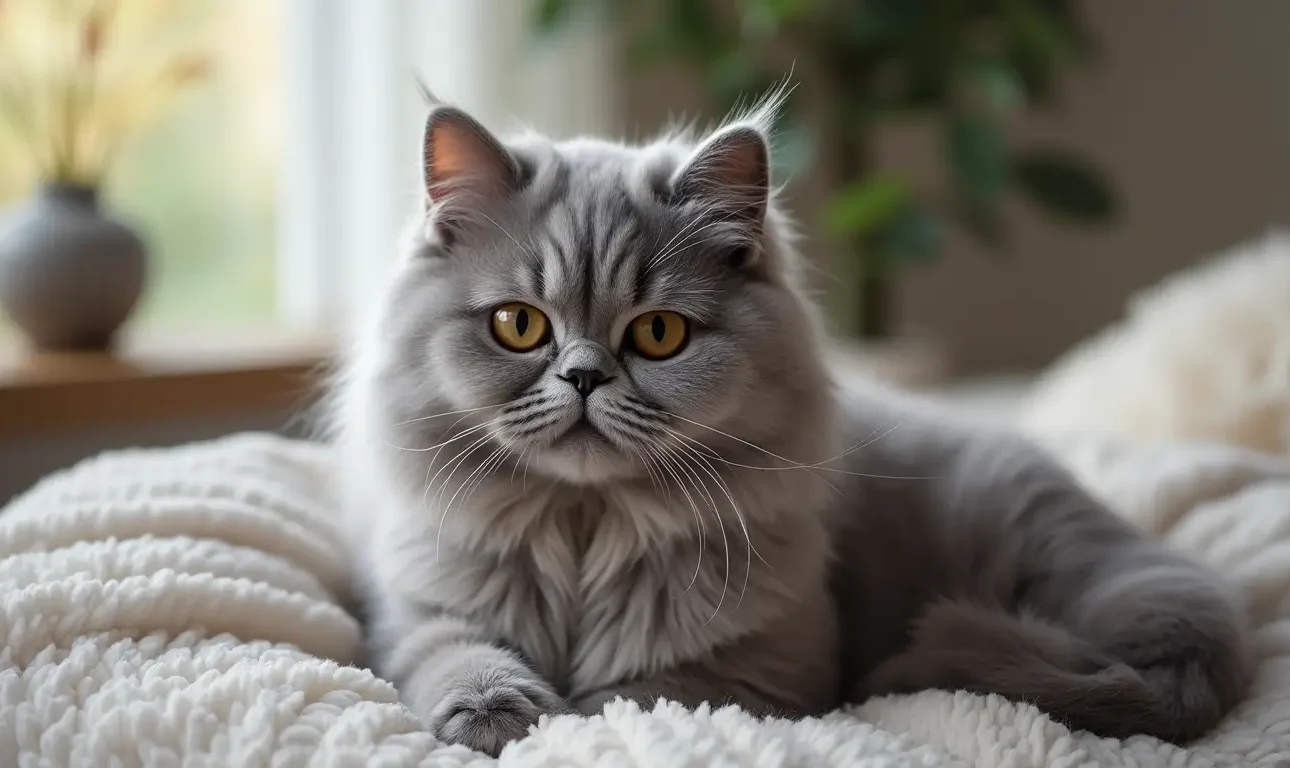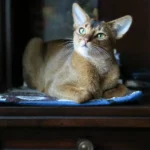Persian cats have long been celebrated for their graceful appearance and calm, affectionate nature. Known for their luxurious coats and distinctive features, these elegant felines have earned a reputation as one of the most beloved cat breeds worldwide. Their serene demeanor, coupled with their striking beauty, makes them a favorite among pet owners who appreciate both sophistication and companionship.
Among the various color variations within the Persian breed, the Gray Persian stands out as a particularly enchanting and unique variation. With their soft, silvery-gray fur, large expressive eyes, and quiet charm, Gray Persians embody a timeless elegance that captivates the hearts of those lucky enough to share their lives with them. This alluring mix of grace and charm is what sets them apart and makes them such a special breed to admire.
However, owning a Gray Persian comes with its own set of responsibilities. These cats require diligent care and attention to maintain their health and beauty. From grooming to diet, understanding the specific needs of your Gray Persian is key to ensuring they thrive and live a happy, healthy life. In this post, we’ll explore what makes Gray Persian cats so captivating and offer insights into how to care for these majestic creatures.
Table of Contents
The Fascinating Traits of Gray Persian Cats
Distinctive Appearance of Gray Persian Cats
Gray Persian cats are renowned for their striking and elegant appearance, which sets them apart from other cat breeds. Their soft, silvery-gray fur comes in a variety of shades, ranging from a delicate, light silver to a deeper, almost charcoal gray. Some Gray Persians may also have subtle patterns, such as a hint of darker shading around the face or on their tails, giving them an air of mystery and refinement.
One of the most remarkable features of these cats is their long, luxurious coats. Their thick, silky fur requires regular grooming to prevent matting and keep it looking glossy and smooth. This plush coat not only enhances their beauty but also adds to their overall regal presence, making them a symbol of elegance. Their large, round faces, often framed by their voluminous fur, create a soft, serene expression that complements their gentle nature.
In addition to their magnificent coat, Gray Persians are characterized by their flat, round faces and large, expressive eyes. These eyes often appear even larger because of the fur surrounding them, adding to their captivating charm. The unique combination of their face structure and eye size contributes to their overall look of peaceful wisdom and quiet grace.
Personality and Temperament
Gray Persian cats are just as enchanting in personality as they are in appearance. Known for their calm and affectionate nature, these cats tend to be particularly gentle, making them excellent companions. They enjoy spending time with their human family members, seeking out cuddles and affection, but they do so with a reserved elegance. Unlike some more energetic breeds, Gray Persians are typically low-energy cats that prefer lounging and observing their surroundings in a calm, relaxed manner.
This temperament makes them ideal indoor pets, especially for families and singles alike. Their serene presence can be a perfect match for a quieter household, and they thrive in environments where they can enjoy peace and comfort. Additionally, their affectionate nature allows them to form strong bonds with their owners, often following them around or curling up in their laps for hours of contentment.
Compared to other more playful or independent breeds, Gray Persians are more likely to enjoy quiet companionship over active play. This means they are particularly suited to owners who are looking for a loving, laid-back companion rather than a highly energetic cat.
Health Considerations for Gray Persian Cats
While Gray Persian cats are generally healthy, they are predisposed to certain breed-specific health issues due to their unique physical traits. One of the most common health concerns is their breathing. Their flat faces, or “brachycephalic” features, can cause respiratory difficulties, making them prone to breathing problems, especially in hot or humid environments. Ensuring they live in a cool, comfortable space and don’t overexert themselves is important for managing this issue.
Another health consideration for Gray Persians is their eyes. They often have large, expressive eyes that are more susceptible to tear staining and eye infections. Regular eye care and cleaning can help prevent these issues and keep their eyes healthy. Additionally, Persian cats, in general, are known for being prone to dental problems and kidney issues, so routine veterinary visits are essential.
Preventive care is crucial for Gray Persians, including regular vet check-ups, a balanced diet, and grooming to ensure their coats and skin remain healthy. By keeping up with their health needs, you can help ensure that your Gray Persian cat leads a long, happy life. Regular grooming not only keeps their coat in top condition but also provides an opportunity to check for any skin issues or abnormalities that might need attention.
Caring for Your Gray Persian Cat: Grooming and Maintenance Tips
Grooming Your Persian Cat’s Luxurious Coat
Gray Persian cats are known for their long, thick, and luxurious coats, which require consistent grooming to maintain their beauty and health. To keep their fur shiny and smooth, it’s essential to invest in the right grooming tools. A high-quality pin brush or a slicker brush is ideal for detangling their long fur and removing any mats. A wide-tooth comb is also useful for gently combing through their undercoat, where tangles are most likely to form.
Ideally, you should groom your Gray Persian at least three to four times a week to prevent mats and tangles from developing. If left unkempt, their long fur can easily become knotted, which could lead to discomfort or skin irritation. In addition to brushing, it’s important to give their coat a regular bath—usually every 4-6 weeks—to keep it clean and healthy. During bath time, use a cat-specific shampoo and conditioner to help maintain the softness and shine of their fur.
To keep their coat looking glossy and vibrant, consider using a cat grooming spray that helps nourish the fur and reduces static. Regular grooming not only keeps their coat looking its best but also strengthens your bond with your Gray Persian, as they typically enjoy the attention.
Managing Shedding and Allergies
Like all long-haired cats, Gray Persians shed regularly, although their thick coats can sometimes make this shedding more noticeable. The amount of shedding can vary depending on the time of year, as cats typically shed more during seasonal changes. Managing shedding effectively requires regular grooming and attention to your home environment. Brushing your Gray Persian several times a week helps remove excess hair and prevents it from accumulating on furniture and floors.
For people with allergies, Persian cats—while not hypoallergenic—can still be a challenge due to their shedding and the dander they produce. If you suffer from allergies, you can minimize exposure by cleaning your home frequently, especially vacuuming carpets and upholstery where cat hair tends to collect. HEPA air purifiers can also help reduce airborne allergens, and frequent hand washing after handling your Persian can help alleviate allergic reactions.
When cleaning your home, opt for a vacuum cleaner designed for pet hair, which will be more effective at picking up fine hairs from your Gray Persian. Additionally, consider using lint rollers to quickly remove fur from clothing and furniture. Keeping your Gray Persian’s grooming routine consistent will also help reduce shedding around the house.
Diet and Nutrition for Gray Persian Cats
Proper nutrition plays a vital role in maintaining the health and appearance of your Gray Persian cat’s luxurious coat. To support their long, silky fur, it’s important to feed them a high-quality cat food that is rich in essential nutrients, such as protein, omega fatty acids, and vitamins. Look for brands that include salmon or chicken as the first ingredient, as these are excellent sources of protein that promote a healthy coat and skin.
Gray Persians, like all cats, also require taurine, an amino acid that supports heart health and overall well-being. For their coat specifically, you might want to look for foods that are supplemented with omega-3 and omega-6 fatty acids to help nourish the skin and fur. Supplements like fish oil or biotin can also be beneficial for improving coat condition and reducing shedding.
Weight management is another critical aspect of caring for your Gray Persian. Due to their laid-back nature, they are prone to becoming overweight if overfed or if they don’t get enough physical activity. Choose a cat food that supports a healthy weight and avoid overfeeding. Keep track of portion sizes, and ensure your Persian cat has access to fresh water at all times to stay hydrated and support their overall health.
Lastly, always consult your veterinarian about the best diet plan for your Persian, as they may have specific dietary needs depending on their age, health conditions, or activity level. A well-balanced diet, along with regular grooming, will help your Gray Persian maintain their stunning appearance and remain healthy for years to come.
Understanding the Elegance of Gray Persian Cats as Luxury Pets
Why Persian Cats Are Considered Luxury Pets
Persian cats have long been associated with wealth, elegance, and exclusivity, making them a symbol of luxury in the pet world. Their historical significance dates back centuries, with Persian cats often being kept by royalty and aristocrats. In fact, the breed’s lavish fur and sophisticated look made it a favorite among European monarchs and Persian nobility. This royal heritage has cemented their status as elite pets—a reflection of both opulence and grace.
Owning a Persian cat comes with a substantial cost, not just in terms of purchase price but also in the ongoing care required. Their long, thick coats demand regular grooming, and they may also require specific diets, regular vet visits, and health maintenance. These costs, combined with the time commitment for daily care, contribute to the breed’s reputation as a pet that is suited for those who appreciate and are willing to invest in their upkeep.
The personality and appearance of Persian cats further enhance their status as luxury pets. Known for their serene and affectionate nature, they offer a calm companionship that aligns perfectly with the sophisticated, relaxed lifestyle many luxury pet owners seek. Their beauty, combined with their dignified and affectionate demeanor, makes them the ideal companion for those who appreciate both the visual and emotional richness of having a high-maintenance, elegant pet.
Persian Cats in Popular Culture
Persian cats have appeared in a variety of media, art, and movies, reinforcing their association with luxury and elegance. In films and TV shows, Persian cats are often portrayed as companions to wealthy characters, further adding to the mystique of owning one. Perhaps the most famous Persian cat in pop culture is “Grumpy Cat”, whose signature scowl and massive online following brought even more attention to the breed’s unique looks.
Beyond the media, Persian cats have been featured in art and literature for centuries. Their beauty and majestic presence have inspired painters, photographers, and writers who have immortalized them in various forms of creative expression. This cultural relevance contributes to their image as an exotic, rare breed.
Many celebrities are also known for owning Persian cats, further cementing their image as a luxury pet. Famous personalities such as Marlene Dietrich, Elizabeth Taylor, and Kourtney Kardashian have all owned Persian cats, which has only added to the allure of these elegant felines. The ownership of a Gray Persian cat, with its distinctive and rare appearance, carries with it an air of exclusivity and prestige, making it a status symbol in many circles.
What to Expect as a Gray Persian Cat Owner
Owning a Gray Persian cat is a commitment that requires both time and effort, but the rewards are immense. These beautiful cats demand regular grooming, and because of their long coats, daily brushing is often recommended to prevent matting and maintain the softness and shine of their fur. Their serene, low-energy nature also means that they may require a calm, quiet environment to thrive, so you’ll need to be prepared to provide them with a comfortable living space that meets their specific needs.
Despite the care involved, the benefits of having a Gray Persian as part of your family are numerous. Their affectionate nature and tendency to form close bonds with their owners make them wonderful companions. They often enjoy curling up with their humans, offering warmth and comfort, and they can become a beloved part of the family. Their graceful presence and soothing demeanor bring a sense of tranquility to any home.
However, owning a Gray Persian is not without its challenges. As a high-maintenance breed, they may require extra attention when it comes to health care, grooming, and general upkeep. Persian cats are also prone to certain genetic health issues, such as respiratory problems due to their flat faces and potential kidney concerns. These health challenges, combined with the time and cost required to maintain their appearance, mean that owning a Gray Persian should be a decision made with careful consideration.
In conclusion, while owning a Gray Persian cat can be demanding, the love, companionship, and beauty they offer in return make them a luxury pet that will be cherished for years. Their elegance and affectionate nature make them more than just a pet—they become a part of the family, bringing joy, calm, and beauty to any home lucky enough to welcome them.
Essential Tips for Raising a Happy and Healthy Gray Persian Cat
The Importance of Early Socialization
Socializing your Gray Persian cat from a young age is crucial to ensuring they develop into well-adjusted, confident adults. Early socialization helps Persian kittens become accustomed to various sounds, people, and environments, which makes them more adaptable and less anxious as they grow. It’s important to expose them to different situations, such as being around new people, loud noises, and different rooms in the house. The more positive experiences they have, the better they’ll adjust to new situations throughout their life.
Encouraging positive behavior in Persian kittens starts with gentle handling and consistent reinforcement. When your Persian kitten shows curiosity or interacts positively with their environment, reward them with treats or affection. This will help them associate new experiences with positive outcomes. Start early with basic training, such as teaching them where to scratch, and providing them with safe and engaging toys to promote good habits.
If you have other pets in your home, it’s important to start the process of socializing with other animals early on. Introduce your Gray Persian kitten to other pets slowly, allowing them to get used to one another in a controlled environment. It’s important to supervise interactions and provide safe spaces for each pet to retreat to if they feel overwhelmed.
Creating the Perfect Indoor Environment
Gray Persians are primarily indoor cats, and they thrive in an environment that is both comfortable and stimulating. Setting up a cat-friendly home involves creating a space where your Persian can explore, rest, and feel safe. Provide a variety of scratching posts, toys, and cat trees to give them the opportunity to engage in natural behaviors like climbing and scratching. Persian cats appreciate having spaces where they can safely perch and observe their surroundings from above, so vertical spaces such as shelves or window perches are highly recommended.
Cozy resting spots are also essential for a Gray Persian cat. These cats are known for enjoying long naps, and they appreciate having a quiet, soft place to retreat to when they need rest. A comfortable cat bed, placed in a peaceful corner of the house, will allow your Persian to relax and recharge. Ensure that your Persian has access to warm, quiet areas where they can feel safe and secure, as they tend to be more sensitive to noise and commotion than other breeds.
Keeping their environment clean and safe is equally important. Gray Persians are prone to eye discharge and shedding, so cleaning their living area regularly is crucial for their well-being. Vacuuming up fur, wiping down surfaces, and changing bedding frequently will ensure a hygienic environment for your cat. Additionally, ensure that your home is cat-proofed, meaning keeping toxic plants, dangerous chemicals, or small objects out of reach to avoid potential hazards.
Regular Vet Visits and Preventive Care
Gray Persian cats, like all purebred cats, require regular vet visits to ensure their health and well-being. It’s important to schedule routine check-ups with a veterinarian who is familiar with the breed’s unique needs. During these visits, the vet will check your Persian for any signs of health issues and offer vaccinations or other preventive care.
Key vaccinations for Persian cats include rabies, feline distemper, and feline herpesvirus. Your vet will recommend an appropriate vaccination schedule based on your cat’s age and health history. Routine health check-ups are also essential for monitoring your cat’s weight, dental health, and overall physical condition. Persians are prone to certain genetic conditions, such as breathing issues due to their flat faces, and kidney disease, so regular vet visits will help catch any health problems early on.
To prevent common health issues that Persian cats face, it’s important to be proactive about their care. For example, maintaining a healthy diet that supports kidney health and managing their weight will reduce the risk of obesity, a common issue in Persians. Dental care is also essential, as Persian cats are prone to dental disease. Regular teeth brushing and professional cleanings, as recommended by your vet, will help ensure your Persian’s long-term health. Regular grooming is also key to preventing skin infections, matting, and eye problems. By staying on top of these preventive measures, you can ensure your Gray Persian cat lives a long, healthy life.
Conclusion: The Timeless Elegance of Gray Persian Cats
Gray Persian cats are truly a sight to behold, embodying both beauty and elegance in every aspect of their being. Their luxurious silvery-gray coats, expressive eyes, and serene demeanor make them not only captivating to look at but also deeply endearing companions. With their calm personalities and gentle nature, Gray Persians offer a unique blend of grace and affection, making them the perfect choice for those seeking a loving and sophisticated pet.
Beyond their stunning appearance, Gray Persians are also wonderful companions, providing constant comfort and companionship to their owners. They thrive in peaceful, nurturing environments, where they can relax and be pampered, and their quiet affection makes them ideal pets for families, singles, and those with quieter lifestyles. Though they require dedicated care, the joy and beauty they bring into your home more than make up for the extra effort.
By taking the time to properly care for your Gray Persian cat—through grooming, a healthy diet, regular vet visits, and a loving home environment—you can ensure that they live a long, happy life, enriching your life in return. Embrace the joy and elegance that a Gray Persian brings into your world, and you’ll experience the timeless charm of this extraordinary breed firsthand.
FAQ: Gray Persian Cats
1. What makes Gray Persian cats unique compared to other Persian cats?
Gray Persian cats stand out due to their striking silvery-gray coats, which vary in shade from light silver to deeper charcoal. Their luxurious fur, combined with their distinctive large, expressive eyes and flat faces, gives them a particularly elegant and majestic appearance. Their calm and affectionate temperament also sets them apart from other Persian variations.
2. How often should I groom my Gray Persian cat?
Gray Persian cats have long, thick coats that require regular grooming to prevent matting and keep their fur shiny. It’s recommended to brush your Gray Persian at least three to four times a week. Daily grooming can be beneficial to maintain their coat’s softness and prevent tangles, especially in the undercoat.
3. Are Gray Persian cats hypoallergenic?
Gray Persian cats, like all Persians, are not considered hypoallergenic. While they may produce less dander than some other breeds, they still shed hair, and the proteins in their fur can trigger allergic reactions in sensitive individuals. Regular grooming and cleaning can help minimize allergens in your home.
4. How can I prevent my Gray Persian from developing health issues?
To keep your Gray Persian healthy, it’s important to schedule regular vet check-ups, maintain a balanced diet, and ensure proper grooming. Persians are prone to certain genetic conditions like breathing problems due to their flat faces and kidney disease, so routine health monitoring and preventive care, including vaccinations and dental hygiene, are crucial for their well-being.
5. Are Gray Persian cats good pets for families?
Yes, Gray Persian cats are known for their calm and affectionate nature, making them great companions for families. They are typically friendly and enjoy being around their human family members, but they tend to prefer quiet environments. They are especially well-suited for indoor living and can form strong bonds with their owners.
6. How much do Gray Persian cats cost?
The cost of a Gray Persian cat can vary widely depending on factors such as the cat’s pedigree, age, and where you acquire it. On average, Persian cats can range anywhere from $500 to $5,000 or more, with show-quality cats costing on the higher end of the spectrum. Keep in mind that owning a Persian cat involves ongoing costs for grooming, food, and vet care.
7. Can Gray Persian cats get along with other pets?
Gray Persian cats can get along with other pets, especially if they are introduced to them early on. With proper socialization, they can coexist peacefully with other cats, dogs, and even children. However, their calm and reserved nature may make them more sensitive to the presence of overly energetic or dominant pets. Careful introductions and supervision are key.
8. What should I feed my Gray Persian cat to keep their coat healthy?
Gray Persians benefit from a high-quality, well-balanced diet that includes protein, omega fatty acids, and vitamins. Look for foods that promote coat health, such as those with salmon, chicken, or added fish oils. Additionally, consider consulting with your vet to determine if any supplements, such as fish oil or biotin, are appropriate for maintaining their beautiful coat.
9. Do Gray Persian cats require a lot of exercise?
Gray Persian cats are typically not very active and tend to be more laid-back. They enjoy lounging around and observing their environment but can still benefit from short, interactive play sessions to keep them mentally and physically stimulated. Regular playtime with toys can help keep them engaged and prevent obesity.
10. How do I care for my Gray Persian cat’s eyes?
Gray Persians, like other Persians, are prone to tear staining and eye infections. To care for their eyes, it’s important to clean their tear ducts regularly with a damp, soft cloth to prevent buildup and staining. Keeping their eyes free from discharge helps maintain their overall health and prevents irritation. Regular veterinary check-ups will also help monitor eye health and prevent potential issues.






